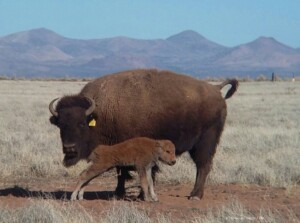
American Bison in the Janos Biosphere Reserve in Chihuahua, just east of the Sonoran Sky Islands. Photo credit: CONANP
Northern Mexico has had a tragic history of iconic wildlife extinctions due to hunting and persecution by government agencies and landowners. The Mexican Grizzly Bear or Mexican Silvery Bear (Ursus arctos nelson), for example, was a subspecies of the Grizzly Bear (Ursus arctos) that used to roam across Chihuahua, Coahuila, Sonora, and Durango and was gradually hunted down so that in 1960 there were only 30 specimens reported. In 1976, after it was believed extinct, one individual was found in Sonora and shot shortly after.
Similarly, the Mexican Gray Wolf (Canis lupus baileyi) – the smallest subspecies of the North American gray wolf – used to inhabit most of northern and central Mexico; and just as the Mexican Grizzlies they were hunted down and poisoned. In fact, Mexico managed to completely extirpate the Mexican Wolf from its territory by 1970 thanks to a binational “cooperation program” led by the U.S. Fish and Wildlife.
Sadly, horrific stories like this abound in Mexico; the extinction of the Imperial Woodpecker (Campephilus imperialis) in the Western Sierra Madre, the extirpation of the American Bison (Bison bison) from the plains of Chihuahua, and now, the seemingly imminent extinction of the Vaquita Marina (Phocoena sinus) in the Gulf of California. Fortunately, just when the extinction crisis in Mexico was seemed to be unstoppable, Mexican civil society and academia started organizing vigorously to prevent further extinctions and restore some of the biological treasures that the country had lost. Such was the case of a group of students and academics from the University of Chihuahua led by Dr. Julio Carrera who saw the need to act. It took 12 years for this group of enthusiasts to formally be formally constituted as the non-profit Profauna A.C. which since then has been instrumental in the conservation and rewilding or northern Mexico.
Perhaps one of Profauna’s most remarkable contributions to conservation in Mexico has been the recent successes with reintroducing the American Bison in the Janos Biosphere Reserve just east of the Sonoran Sky Islands, and the reintroduction of the American Pronghorn (Antilocapra Americana) also in Janos as well as in the Sonoran Sky Islands and in Baja California. But Profauna has had key contributions to conservation beyond these iconic species, as they have also been critical in changing local communities’ perception of wildlife and conservation in general, and to connect with local land owners and gain their trust, something crucial if you are to work in regions of Mexico that have been historically forgotten and marginalized. They have done this through carefully planned environmental education and capacity building programs.
Profauna and Sky Island Alliance have been working together for several years now, but this year we launched a strategic, long-term partnership to work across the private lands that surround the Bavispe Wildlife Protection Reserve – the only federal protected area in the Mexican Sky Islands. Because of the unprecedented budget cuts that Bavispe and all of CONANP (the Mexican Park Service) are suffering, our partnership with Profauna is more important than ever. “Ranchers are excited an open to work with us right now, and this is something that wasn’t common in the past. We need to support them now so we can build long-lasting working relationships with them” told me earlier this year Antonio Esquer, regional coordinator of Profauna in Sonora.
We are very excited to be working with Profauna and benefit from all their knowledge in the Sky Islands and the ecosystems and human communities of northern Mexico. This Thursday, November 12th, join us for a Coffee Break featuring Antonio Esquer and Mario Cirett as they tell us the story of the Upper San Pedro River watershed in Sonora and how this region has been so emblematic for U.S. – Mexico cooperation.



